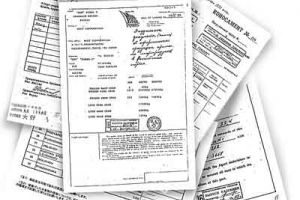| Bill of lading |
|
Nowadays more than 80 % of all the cargos are delivered by sea and about 90% of the marine fleet deals with the export shipping. With this high turnover volume, the uniform documentation and goods (transported by sea) registration system is of great importance.
A bill of lading (derived from the French notion « Le connaissement»; sometimes abbreviated as B/L) is a document of title that contains provisions and conditions of the sea transportation contract, certifies the fact of its concluding and serves as a proof of the goods acceptance for the transportation. As well it provides documentary evidence of the cargo ownership. HISTORICAL NOTE. The emergence of the Bill of Lading is dated 1242. At that time B/L contained only one note that its signer is obliged to carry the goods on his own vessel. The B/L was made up and signed particularly by the ship owner or by the captain but it was handed in only to the cargo shipper. Later the initial B/L became similar to the present one when its records and characteristics from the cargo register extract were put together in its form. On legal grounds the B/L was issued in Russia in year 1926 after the release of the «Sea transportation regulations». Before the beginning of the 19th century only the on board bill of lading was practically applied. An on-board bill of lading denotes that the goods were physically loaded onto the certain shipping vessel. However from the middle of the 19th century the cargo was preliminarily placed in the special warehouses or the berths for the further loading on the shipboard. For that kind of cargo the other type of B/L was issued it contained the note «Received for the shipment». That type of B/L was later renamed, a received for shipment, bill of lading. Nowadays the legal regulation of B/L operates with the standards of the Merchant Marine Code of the Russian Federation from 2005.The holder of all 3 original bills of lading has the right to dispose of the cargo. If the cargo is released under authority of 1 original B/L, then the remaining two bills of lading lose their legal validity. In the B/L the following specifications are stated: • Forwarder Any extra data can be added at the request of the opposite party Types of B/L General classification • Negotiable B/L (consignee is not specified). It can be bought or sold or serve as a pledge and so on. It is up to the owner of B/L to decide how to dispose of cargo while it is on the seaway. To the negotiable B/L we can refer the bearer and to-order bills of lading. By the consignee. • Straight B/L – the individual or the legal body acts as a consignee in whose name the B/L was issued. By the type of transportation. • Liner B/L deals with the vessel running through the regular routes in accordance with the established time schedule. By the number of the forwarder`s remarks • Clean B/L denotes that the cargo is in good condition upon being received by the shipping carrier By the transporting scheme. • Straight B/L for the transportation kind of port-to-port At the time of loading. • Shipped on board B/L is issued after the cargo was placed on the board of the vessel Work procedure with the conosament. 1. To issue the B/L the freight forwarder compiles the loading order with the following information: description and brand name of goods, its quantity, type of packaging, departure/destination port, shipper`s and consignee`s data, name of vessel IN PRACTICE the above-described process is a standard procedure of the B/L issue. In practice quite often the other situations occur. For example, sometimes the cargo has been brought to the port but the B/L is not received it yet as its sending was delayed by some reasons. In this case the cargo shipper is to address to the closest agent of the container line with the notification to transmit «telex» by mean of communication lines. However the agent should be provided with 3 originals of B/L on its authority the telex release will be transmitted. After it the information is available all over the net of the container line. Consequently the consignee can turn to his agent in order to obtain the documents and title of the ownership for the delivered cargo. Telex release is quite often used in such cases especially if the consignee delays the payment to the utmost. As a result no time is left at all to receive the B/L. Telex release gives the right to the ownership for the cargo. The payment delay is customary among the consignees. Telex release became the only way out of the situation of the mutual distrust between the consignee and the supplier. 3. The final step is the receipt of cargo by the consignee at the destination port with the help of telex release or by providing of 3 originals of B/L that were sent by post. |




